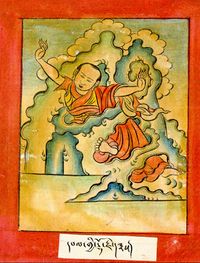لانگدارما
لانگدارما (Langdarma ؛ وايلي: glang dar ma "الثور البالغ" أو "ثور الدارما"، الاسم اللائق U Dumtsen وايلي: 'u dum btsan) كان امبراطور التبت، الذي حكم غالباً من 838 إلى 841 م. المصادر المبكرة تسميه تري دارما "الملك دارما". امتد ملكه وراء التبت ليضم دونهوانگ و المناطق الصينية المجاورة.[1]
. . . . . . . . . . . . . . . . . . . . . . . . . . . . . . . . . . . . . . . . . . . . . . . . . . . . . . . . . . . . . . . . . . . . . . . . . . . . . . . . . . . . . . . . . . . . . . . . . . . . . . . . . . . . . . . . . . . . . . . . . . . . . . . . . . . . . . . . . . . . . . . . . . . . . . . . . . . . . . . . . . . . . . . .
التاريخ
حسب الموروث، فإن لانگدارما كان معادياً للبوذية ومؤمناً بعقيدة بون. ويُنسب إليه اغتيال شقيقه الملك رلپاتسان، في 838. كما يُنسب إليه اضطهاد البوذيين. وحسب الروايات التقليدية فقد ظل متبعاً للبوذية في أول عامين من حكمه، ولكن بتأثير من ويگيل تورى (وايلي: dbas rgyal to re)، اعتنق عقيدة بون، حتى نهاية عهده في 842.
تصويره كمعادي للبوذية يشكك فيه عدد من المؤرخين،[2] أهمهم زويهو ياماگوتشي.[3]
اتسم عهد لانگدارما بالمشاكل الخارجية. فقد انهارت خاقانية الأويغور، إلى الشمال، بسبب ثورة قيرغيز ينيسـِيْ في عام 840 وهاجر العديد منهم إلى التبت. وحسب أحد المصادر، فقد حكم لانگدارما لمدة عام ونصف، بينما يزعم آخرون أنه حكم لست أو ثلاثة عشر سنة.[4]
اغتياله
وحسب الموروث التقليدي فقد قام ناسك أو راهب بوذي، يُدعى لالونگ پلگيي دورجى باغتيال لانگدارما في 842 أو 846.[4][5] وتلت وفاته حرباً أهلية وانحلال الامبراطورية التبتية، مما أدى إلى عصر التشظي.[1]
سلالته
يقال أن لانگدارما أنجب ولدين: Tride Yumten، من زوجته الأولى، و Namde Ösung من زوجته الثانية.[6] ويبدو أنهما تنافسا على السلطة، فالأول كان يحكم المملكة الوسطى Ü، والآخر حكم "الجناح الأيسر"، لعله المناطق الشرقية.[4]
أحد أحفاد لانگدارما، Kyidé Nyima Gön (وايلي: skyid lde nyi ma gon), conquered Ngari in the late 10th century, although his army originally numbered only 300 men. Kyidé Nyima Gön founded several towns and castles and he apparently ordered the construction of the main sculptures at Shey. "In an inscription he says he had them made for the religious benefit of the Tsanpo (the dynastical name of his father and ancestors), and of all the people of Ngaris (غرب التبت). This shows that already in this generation Langdarma's opposition to Buddhism had disappeared."[7] شـيْ، على بعد 15 كم شرق بلدة له، المقر القديم لملوك لداخ.
الهامش
- ^ أ ب Samten Karmay in McKay, Alex (2003). Tibet and her neighbours : a history. London: Edition Hansjörg Meyer. ISBN 3883757187., pg. 57
- ^ Jens Schlieter. "Compassionate Killing or Conflict Resolution? The Murder of King Langdarma according to Tibetan Buddhist Sources". University of Berne.
- ^ Yamaguchi, Zuiho. “The Fiction of King Dar ma's Persecution of Buddhism.” in Drège, textes réunis par Jean-Pierre (1996). De Dunhuang au Japon : études chinoise et bouddhiques offertes à Michel Soymié. Genève: Droz. ISBN 2600001662.
- ^ أ ب ت Stein, R. A. (1972). Tibetan civilization ([English ed.]. ed.). Stanford, Calif.: Stanford Univ. Press. ISBN 0-8047-0901-7., pp. 70-71
- ^ Beckwith, Christopher I. (1993). The Tibetan empire in Central Asia : a history of the struggle for great power among Tibetans, Turks, Arabs, and Chinese during the early Middle Ages (4. print., and 1st pbk. ed.). Princeton, NJ: Princeton Univ. Press. ISBN 0-691-02469-3., pp. 168-169
- ^ Davidson, Ronald M. (2008). Tibetan renaissance : Tantric Buddhism in the rebirth of Tibetan culture (1st Indian ed.). Delhi: Motilal Banarsidass Publishers. ISBN 978-8120832787.
- ^ Francke, A. H. (1914). Antiquities of Indian Tibet (2 volumes) (1972 reprint ed.). S. Chand., pp. 89-90.
وصلات خارجية
- http://www.haiweitrails.com/timeline_tibet.htm (accessed: Sunday January 14, 2007)
| ألقاب ملكية | ||
|---|---|---|
| سبقه رلپاتسان |
امبراطور التبت r. 838–841 |
تبعه 'Od-srung (گوگى) و يوم-برتان (لاسا) |
خطأ لوا في وحدة:Authority_control على السطر 278: attempt to call field '_showMessage' (a nil value).

